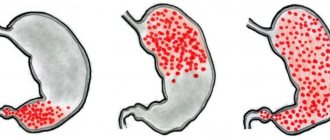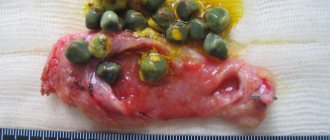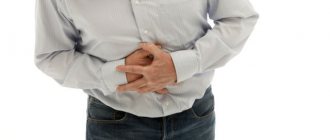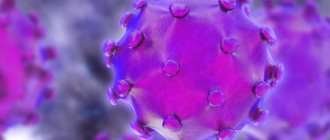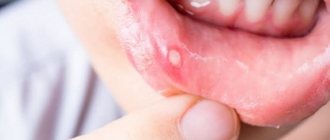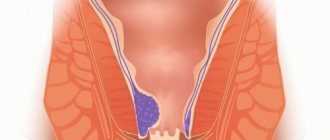Meniere's disease is a disease of the inner ear of unknown etiology. During an attack of the disease, tinnitus, dizziness and hearing loss are observed. The duration of vestibular crises ranges from several minutes to several days and may be accompanied by nausea, vomiting, increased sweating and imbalance. The prognosis is favorable, but repeated attacks are painful for the patient and lead to decreased ability to work.
The main goal of treatment for Meniere's disease is to relieve and prevent attacks. If conservative therapy is ineffective, surgical intervention is indicated for patients.
Meniere's disease: causes
There is currently no underlying cause of Meniere's disease. To better understand the mechanism of development of the disease, let us briefly consider the anatomy and physiology of the inner ear.
Anatomy and physiology of the inner ear
Anatomically, the hearing organ consists of three parts:
- The outer ear includes the external auditory canal and the pinna;
- The middle consists of the auditory ossicles, the Eustachian tube and the tympanic cavity;
- The inner ear includes the sensory apparatus of the organ of hearing and balance. The vestibular analyzer consists of the vestibule of the cochlea and the semicircular canals. The auditory analyzer is located in the cochlea. The cochlea is a bony, spirally convoluted canal, tapering from the base to the apex. Inside the bone canal there is a membranous labyrinth, completely repeating the structure of the first. The membranous labyrinth is filled with endolymph and bone perilymph. Perilymph is similar in composition to cerebrospinal fluid as it communicates with the subarachnoid space of the brain. The cochlea contains three sections: the vestibular, middle and tympanic scala. The vestibular septum is separated from the scala mediali by Reisner's septum, and the scala mediali is separated from the scala tympanum by the basilar membrane. The birth of a nerve impulse is ensured by the activity of the cells of the organ of Corti. This is an accumulation of neuroepithelial elements on the basilar membrane. Cells of the organ of Corti perceive and transform auditory stimuli into a signal for the brain.
Sound is produced by the passage of air through the auricle to the eardrum, which causes the auditory ossicles to move. The vibrations of the ossicles cause the movement of the peri, then the endolymph. This in turn excites the auditory receptors and a nerve impulse is born that goes to the hearing center of the cerebral cortex.
Development mechanism
Meniere's disease is also called endolymphatic hydrops. The second name refers to the pathogenesis of the disease. Endolymphatic hydrops is an increase in the volume of lymph in the membranous labyrinth. An increase in endolymph causes stretching, and subsequent rupture, of the Reissner membrane. As a result, the endo and perilymph mix and their ionic balance is disrupted. The composition of the perilymph changes with a predominance of potassium, and nerve cells lose their ability to excite. This causes attacks of dizziness. Hearing loss occurs as a result of the death of spiral ganglion cells.
Causes of Meniere's disease
Enlarged endolymph can be caused by:
- Congenital anomalies: absence of the peri-vestibular canaliculus vein, underdevelopment of the cochlea;
- Hereditary predisposition;
- Endocrine disorders, especially adrenal and thyroid disorders;
- Atherosclerosis, spasm of the coronary arteries;
- Degenerative changes and spinal injuries;
- Violation of carbohydrate, fat, protein and water-salt metabolism;
- Vegetovascular dystonia;
- Hypercoagulation;
- Autoimmune processes;
- Hypovitaminosis.
Poisoning with alcohol, drugs and allergies can provoke vestibular crises. The role of cytomegalovirus and herpes simplex virus among the causes of Meniere's disease has now been proven.
Classification of Meniere's disease
Meniere's disease should be distinguished from the syndrome of the same name. Meniere's syndrome is a concomitant factor of a certain disease; BM represents an independent nosological unit.
Meniere's disease according to ICD-10 corresponds to class H81—vestibular function disorders, code H81.0.
Along the course, endolymphatic hydrops occurs:
- Classic, when auditory and vestibular disorders appear simultaneously;
- If the balance is first disturbed - vestibular;
- In the cochlear form, auditory disorders primarily occur.
According to the severity, BM is classified into mild (short attacks with a break of at least a month), moderate (crises up to 6 hours) and severe (exacerbations once a day with loss of ability to work). There are also reversible and irreversible forms of the disease. If reversible, it is possible to restore the functions of the auditory analyzer.
Stages of tendinitis
Modern medicine distinguishes several stages of this disease. These include:
- Acute phase. The damaged area of the body causes severe pain. If a person feels discomfort in a calm state, then with physical activity it develops into unbearable acute pain;
- Subacute phase. The pain persists and is accompanied by swelling. Movements become difficult and limited;
- Chronic phase. Tissue degeneration occurs. Pain becomes a constant “guest”, as does stiffness.
Symptoms of Meniere's disease
The disease is named after the French physician Prosper Meniere. He was able to prove the connection between hearing impairment and pathology of the hearing system, and not the brain. Meniere was treating a patient who suddenly developed deafness after hypothermia; she died a few days later. At the autopsy, blood was found in the semicircular canals, while no abnormalities were found in the central nervous system.
Meniere's disease occurs with periods of exacerbations and remissions. The process is often one-sided, with the exception of autoimmune lesions. The primary signs of an attack of endolymphatic hydrops are sudden (labyrinthine attacks) dizziness, tinnitus and gradually increasing hearing loss. Secondary symptoms of endolymphatic hydrops crisis:
- Nausea, vomiting;
- Increased sensitivity to loud sounds;
- Nystagmus - frequent vibrations of the eyeballs;
- Diarrhea;
- Frequent urination;
- Increased salivation;
- Increased sweating;
- Blood pressure is usually reduced;
- Heaviness, sensation of pressure on the side of the affected ear.
Labyrinth attacks occur suddenly, often at night or during the day. Attacks occur against the background of normal health, but they can be triggered by stress, malnutrition, poisoning, allergic reactions and physical stress. Sometimes patients feel the onset of an attack several hours or even days in advance. Attacks with BM are divided into:
- Frequent (1-2 times a day, week, month);
- Rare (several times a year);
- Episodic (once every couple of years).
Vestibular disorders in peripheral type MD. This type of imbalance is characterized by systemic vertigo and horizontal nystagmus. Systemic (true) dizziness occurs when the receptors of the balance organ are irritated. For differential diagnosis of the type of dizziness, the Dix-Hallpike test is used.
The duration of attacks varies from several hours to several days. After a crisis, in the first 48 hours the patient feels fatigue and decreased ability to work. In severe and moderate forms of the disease, there is no working capacity. During remissions the condition is satisfactory.
Dizziness
The very first symptom of a labyrinthine attack is dizziness (vertigo). It is caused by irritation and compression of the vestibular analyzer receptors. Dizziness with MD is characterized by a feeling of rotation of oneself or objects, and imbalance. The symptom is often accompanied by migraine-like headaches. During an attack, patients often cannot stand on their feet and take a horizontal position. For relief, patients close their eyes. Any movements of the head and body cause deterioration of the condition, increased dizziness, nausea and vomiting. An objective sign of exacerbation is nystagmus. It can be observed not only during the crisis, but also after the crisis for up to one week. Nystagmus in Meniere's disease can change direction: at the beginning of the attack it is directed towards the diseased ear, and at the end towards the healthy ear. Vertigo can be dangerous and cause injury because it often occurs suddenly without any previous symptoms. To eliminate this symptom, radical measures are often resorted to - removal of the vestibular nerve. In the final stage of the disease, instantaneous falls without dizziness occur (Tumarkin crises).
Hearing loss
During vestibular crises, patients note hearing impairment. Subjectively, the condition is described as congestion, a feeling of fullness or heaviness in the ear. Hearing loss in Meniere's disease is fluctuating. Fluctuating hearing loss is characterized by changes in hearing acuity - a decrease before and during attacks. Some patients experience a decrease in hearing acuity with each attack. Hearing loss is usually unilateral, but as it progresses, a second organ may be affected. This symptom is detected by audiometry. In the first stages of the disease, the perception of low frequencies is impaired. Sensorineural hearing loss increases as degenerative processes of spiral ganglion neurons increase.
Noise in ears
Tinnitus is low or mid-frequency. It intensifies before and reaches its maximum during attacks. The ringing is sometimes accompanied by pain in the affected ear.
Meniere's disease occurs in three stages:
- Initial (reversible) stage. Patients are bothered by rare (several times a year, sometimes every 2 years) attacks lasting an average of 2 hours. During this period, patients complain of tinnitus, vestibular dizziness, a feeling of fullness and pressure in the ear, nausea and vomiting. Tinnitus is intermittent, intensifies before an attack, and reaches maximum strength during a vestibular crisis. The first stage is characterized by fluctuating hearing loss, when the hearing loss is unstable. Hearing loss may be absent during the first attacks. However, in the future, hearing loss intensifies during the attack and is restored after its end. Sometimes hearing loss disappears immediately after a vestibular crisis and reappears a few days later. At the initial stage, the hearing threshold deteriorates when perceiving sound with low and medium frequencies. Nystagmus is recorded only during attacks and can last for several days.
- The second is the stage of pronounced clinical manifestations. During this period, all the symptoms of Meniere's disease are observed. Attacks are recorded every day or several times a month. Vestibular attacks are accompanied by severe dizziness, vomiting, increased sweating and other autonomic disorders. Tinnitus occurs constantly and may intensify during vestibular attacks. Also, patients are always bothered by a feeling of pressure, ear congestion and hearing loss on the affected side. According to the results of audiometry, hearing loss is usually grade I-III. A dehydration test in the second stage of Meniere's disease shows persistently increased pressure within the labyrinth. On vestibulometry, hyporeflexia of the labyrinth is noted, and during attacks - hyperreflexia.
- The third, final stage, is also called “burnt out”. During this period, dehydration tests do not provide relief from symptoms, and the patient is completely unable to work. Attacks of dizziness become less frequent, and imbalances, on the contrary, become more frequent. Fluctuating hearing loss is replaced by persistent, permanent hearing loss on the affected side, up to complete loss. At the third stage, the disease progresses and the second ear is involved in the pathological process. Vestibulometry displays hypo-, in advanced stages, and areflexia of the labyrinth. With Meniere's disease at the final stage, Tumarkin crises may occur - an instant fall without loss of consciousness. Tumarkin crises appear as a result of damage to the receptors of the vestibular analyzer.
Meniere's disease most often affects people aged 20-50 years. The connection with gender is ambiguous: some authors indicate a more frequent occurrence in women, others in men. Among children, the disease is extremely rare.
Causes of development and risk factors
- foodborne illness, which develops when bacteria enter the intestines along with food;
- enteritis or colitis (secondary spread of inflammation to the bauginian valve);
- an allergic reaction to eating foods to which the patient is hypersensitive;
- helminthic infestations;
- nervous disorders, constant psycho-emotional stress;
- endocrine disorders (diabetes mellitus, hypothyroidism, thyrotoxicosis);
- nutritional errors - unbalanced diet, insufficient intake of protein in the body (for example, against the background of a vegetarian diet);
- obesity and other metabolic disorders;
- low physical activity, sedentary lifestyle;
- disturbances in peristalsis, frequent constipation or diarrhea.
Diagnosis of Meniere's disease
The diagnosis of Meniere's disease is established taking into account specific symptoms and the results of instrumental studies. The American Academy of Otolaryngologists, based on clinical manifestations, distinguishes three degrees of reliability of BM: possible, probable and definite BM. An important diagnostic criterion is the triad of symptoms - dizziness, tinnitus and hearing loss. The diagnosis is confirmed by gradual deterioration of hearing and repeated episodes of vestibular attacks.
Among the instrumental methods for diagnosing Meniere's disease are:
- The main method, according to international diagnostic criteria, is pure tone threshold audiometry. The result of such a study will be an audiogram, which graphically depicts the function of the hearing organ;
- Otoscopy is performed to exclude middle ear pathology;
- Extratympanic electrocochleography evaluates the performance of the auditory nerve;
- A tuning fork test determines the type of hearing loss. In this case, the hearing loss is of the conductive type.
These methods allow you to analyze the degree of hearing impairment. Audiometry is the main criterion when choosing treatment tactics. To detect endolymphatic hydrops, doctors use electrocochleography and a dehydration test.
Audiogram for Meniere's disease
An audiogram is used to determine the degree of hearing loss. Before the procedure, the doctor examines the ears; if ear plugs are found, they must be removed. The patient is put on headphones, and signals of different frequencies are sent via a computer. The subject needs to press the button when he hears the signal. In the initial stages, poor perception of low frequencies is recorded.
Electrocochleography
To perform extratympanic electrocochleography, electrodes are placed on the skin of the auricle or eardrum. The electrodes determine the ability of the auditory nerve to generate nerve impulses after a signal is given.
Dehydration test
Before the test, the patient undergoes threshold pure-tone audiometry. Osmotic diuretics (furosemide) are then administered and audiometry is repeated again every three hours, after 24 and 48 hours. The test is positive if there is an improvement in hearing of 10 dB or more after 3-4 hours. During remission of the disease, the study is not very informative.
Multislice computed tomography of the bone labyrinth
MSCT allows you to detect the smallest changes in all organs. The images visualize pathognomonic processes in the inner ear with BM.
To assess disorders of the balance organ, the following studies are used:
- Videonystagmography to detect horizontal nystagmus;
- The video impulse test reflects the vestibulo-ocular reflex and the presence of asymmetry;
- Stabilometry;
- Bithermal bitemporal calorization is performed to evaluate semicircular canal function;
- Rotational tests.
Differential diagnosis of Meniere's disease is carried out with the following diseases:
- Traumatic brain injuries;
- Ischemic attacks. Such attacks last minutes and are observed in elderly people with vascular pathology;
- Other vestibulopathies, they can occur as a result of purulent otitis, otosclerosis, labyrinthitis;
- Tumors of the cerebellopontine fossa;
- Vestibular migraine;
- Otosclerosis. The disease is often bilateral, the main symptoms are cochlear;
- Benign paroxysmal positional vertigo. The attack is intense and occurs in a certain position of the body;
- Osteochondrosis.
To exclude brain tumors, injuries, and anomalies in the structure of the temporal bone, CT and MRI are highly informative.
To choose the right treatment tactics, timely and accurate diagnosis is necessary. At the Yusupov Hospital you can conduct the necessary examinations and receive advice from a highly qualified specialist. The clinic has modern high-quality equipment and diagnostic laboratories.
Tendonitis in pregnant women and its features
This disease is a frequent “guest” of women who are expecting a child. If there are suspicions, then it is preferable not to do an x-ray or computed tomography during the examination. Any medications that a pregnant woman will take must be prescribed by the attending physician and also agreed with the gynecologist. In this case, self-medication will be dangerous not only for the patient, but also for her unborn child.
When the first symptoms of tendinitis appear, doctors advise limiting yourself to physical therapy, rest, and applying cold compresses to the affected area. If you need to relieve inflammation and reduce pain, ointments based on painkillers are prescribed.
If the problem enters an acute phase, the doctor may resort to immobilization of the joint. Antibiotics may be prescribed, but only if a bacterial infection is found and other treatments have been ineffective. In the most extreme cases, surgery is performed on the joint.
Treatment of Meniere's disease
Treatment of Meniere's disease is aimed at stopping and preventing the occurrence of attacks. Depending on the severity of the disease, treatment can be conservative or surgical. At the first symptoms, you should contact an otolaryngologist or neurologist.
Treatment for an attack of Meniere's disease
To relieve an attack of Meniere's disease, the patient is placed on a hard surface, the eyes must be open and fixed at a fixed point, mustard plasters are applied to the neck, a heating pad can be applied to the legs, exposure to loud sounds and bright light must be removed.
In order to relieve an attack of Meniere's disease, drugs are used that can relieve endolymphatic hydrops (diuretics), which leads to a decrease in intralabyrinth pressure. Symptomatic therapy is aimed at normalizing mental status, relieving vomiting and dizziness.
- During an attack, it is effective to administer atropine (1 ml 0.1% solution subcutaneously) to relieve impulses from the irritated labyrinth, 40% glucose solution;
- To eliminate this, dimenhydrate, a vestibular receptor blocker, is used. The effectiveness of betahistine has now been proven. The drug is able to cause dilation of the vessels of the inner ear, which leads to better blood supply, reabsorption and a decrease in the amount of endolymph. Papaverine is also sometimes used among vasodilators;
- In order to eliminate vomiting, antiemetic (antiemetics) drugs of central and peripheral action are used. The most popular substances are in release forms for intramuscular and rectal administration, since during an attack it is often impossible to take them orally due to profuse vomiting. These drugs include metoclopramide and thiethylperazine. Among the substances in the oral form are Bonin, Aviamarin, Ciel;
- To normalize the patient's mental state, sedatives are administered. Diazepam, Lorazepam, Mexidol have a pronounced anxiolytic effect;
- The use of diuretics in Meniere's disease is aimed at increasing diuresis, relieving ear congestion and, as a result, reducing the volume of endolymph (Manit, Diacarb). The use of diuretics must be combined with potassium supplements (Asparkam, Panangin).
- A course of intravenous infusion of sodium bicarbonate will help normalize the alkaline reserve of the blood.
Modern classification of the disease
Tendonitis can be different. There is a certain classification, which is based on the characteristics of inflammation and methods of its treatment. Today, doctors distinguish between serous, purulent, and fibrous inflammatory processes.
Tendinosis is also divided according to the place of its occurrence. There are such tendinitis:
- Temporal.
It causes difficulty chewing food. When the jaw opens, a clicking sound may occur. Often the process is accompanied by discomfort or pain;
- Tendonitis of the shoulder joint.
The disease affects the capsule, which serves as the connection of the tendon with the supraspinatus and biceps muscles. Only an experienced specialist can help solve this problem. With tendinosis of the shoulder joint, the patient cannot fully raise his arm up or move it behind his head;
- Biceps tendonitis
leads to impairment and stiffness of hand movements;
- The disease that affected elbow joint
, does not allow full flexion and extension of the limb in this place. Accompanied by severe pain during physical activity and movement;
- Wrists.
It makes itself felt after physical activity. The patient feels stiffness in his hands, and is also unable to bend and straighten his fingers;
- Hip joint.
It is difficult for a person with this disease to move, let alone run or perform other more intense physical activities. After some time, the joint becomes permanently dysfunctional;
- Knee joint.
With this disease, the tendon in this area is affected. Damage can lead to partial or complete degeneration. The reason is the constant wearing of uncomfortable high-heeled shoes, as well as physical training to the limit. If adequate treatment is not provided, the patient may remain crippled for life;
- Achilles tendon
. Most often, professional athletes and heavy physical labor workers suffer from this problem. The disease is characterized by the presence of painful sensations even at rest. The pain intensifies when walking up stairs, and there is a feeling of stiffness in the joint;
- Feet.
In this case, the pain extends not only to the lesion, but also “radiates” to the lower leg. If you do not undergo treatment, then over time nodules appear in the foot, which make it difficult to move the leg;
Whatever type of tendonitis bothers you, it is important to consult a doctor in time so that he can conduct an examination and prescribe the necessary medications. Self-medication is not only ineffective, but also unsafe for health.
Treatment during the interictal period
Treatment during the interictal period consists of complex therapy: a salt-free diet, diuretics and long courses of betahistine hydrochloride. A salt-free diet is aimed at changing the osmolarity of plasma and endolymph. Patients need to limit their salt intake to 2 g per day. A course of intravenous injections of sodium bicarbonate is required to maintain the acid-base balance of the blood. To improve the therapeutic effect, drugs are prescribed that improve blood circulation in the brain and inner ear (Polyglyukin, Reopoliglyukin, Cavinton), B vitamins, venotonics (Detralex), antispasmodics (Eufillin, Dibazol), sedatives.
In order to reduce the frequency of attacks, patients are advised to limit provoking factors: stress, smoking, drinking alcohol, scuba diving, drinking caffeine; working at heights with moving objects is contraindicated. Currently, there is a good therapeutic effect of taking glucocorticoids orally or as injections into the eardrum.
Surgical treatment of Meniere's disease
Surgical interventions on nerves and their plexuses are effective in the initial stage of Meniere's disease in the first two years. These include:
- Transection of the vestibular nerve is a complex neurosurgical operation. Allows you to preserve hearing, since only the vestibular part of the vestibular-cochlear nerve is removed. However, the following complications are possible: intracranial infections, headaches, liquorrhea;
- Destruction of the cervical node;
- At any stage of the disease, laser destruction of the semicircular canal receptor is possible. This allows you to preserve hearing functions;
Operations aimed at restoring pressure in the membranous labyrinth are indicated for persistent hydrops at stages II-III:
- Drainage of the cochlear duct is carried out by dissecting it;
- Endolymphatic sac bypass;
- Opening the vestibular sacs.
Such surgical procedures have a high therapeutic effect and are not accompanied by complications from auditory perception.
Intratympanic administration of antibiotics, in particular gentamicin, is usually performed for unilateral lesions and may be accompanied by progression of hearing loss.
Non-standard methods of treating Meniere's disease
Among the alternative approaches for treating Meniere's disease, patients often resort to taking herbal medicines, nicotinic acid, bioflavonoids, ginger root, and acupuncture. Currently, patients often use creosote on their own, without a doctor’s advice, to relieve vomiting. Creosote therapy is classified as homeopathy; this type of treatment is poorly studied and includes a large number of side effects.
The complex treatment of Meniere's disease includes physiotherapeutic procedures:
- Head and neck massage;
- Electrophoresis;
- Sea, pine baths;
- UV irradiation of the collar area.
For several years, the Yusupov Hospital has been successfully treating Meniere's disease using new techniques. At the clinic you can get advice from the necessary specialist.
Forecast and prevention of Meniere's disease
Each patient has personal distinctive features, which lie in the nature of the disease, so it is not easy to give an accurate prognosis. This has a great impact on the performance of patients. Often, in order to alleviate the disease, conventional drugs are needed; in special situations, doctors have to try various methods of treatment until they can alleviate the patient’s situation.
There is no prevention for Meniere's disease. But the disease can be caused by head injuries, so wearing a helmet is mandatory when driving some vehicles. Also, if you limit your salt intake, you can reduce the frequency of attacks. Important: avoid stress, tobacco, alcohol.
Complications after tendinitis
Like any other disease, tendon tendinitis can have complications. It is not difficult to avoid them if you start the right treatment on time. However, it may happen:
- tissue ruptures;
- chronic course of the disease, which is accompanied by constant pain;
- processes of bone tissue proliferation, which lead to inflammation of various types.
Timely examination by a doctor and compliance with all his instructions will minimize the likelihood of complications.
Treatment of Meniere's disease in Moscow
Treatment of Meniere's disease in Moscow is carried out at the Yusupov Hospital. The price of treatment depends on many factors. People who really need therapy will receive high-quality diagnostics from the best doctors in Moscow, including doctors of science, winners of prestigious awards in medicine, and some of the leading foreign specialists. Treatment of this disease is the professional area of the Yusupov Hospital staff, in which they are experts. The clinic specializes in such ailments. Dozens of patients have already completed stages of therapy. The latest and most effective techniques are used for treatment.
Causes of joint tendonitis
Many people are interested in the question, where does this disease come from? Most often it occurs in two categories of people. The first is professional athletes who train often, for a long time and for wear and tear. This excessive stress on the body leads to damage to tendons and joints. The second is the age category of people who have “passed” forty. In this case, the cause of tendonitis is age-related disorders in the body.
Damage due to excessive physical activity can be caused by a variety of factors:
- If you start doing exercises without the necessary warm-up and warm-up, and also if you systematically violate the technique of performing them;
- Problems in the hip joint appear when running technique is violated. The foot does not land on the ground correctly, the joint suffers from an impact on a hard surface, since the foot is at the wrong angle;
- Exercises that involve sudden jumps, bends, and turns can also provoke the appearance of a similar problem;
- Using incorrect and uncomfortable shoes when we are talking about outdoor activities and not in the gym;
- Problems with the elbow joint are caused by sudden movements of the hands, accompanied by a violation of the technique of performing exercises. As well as constantly performing the same movement with frequent intervals;
- If you apply too much weight during exercise, tendinitis of the shoulder joint may occur.
The anatomical features of the human skeleton can also cause this disease. For example, problems in the hip joint may be caused by unequal leg lengths. Custom-made shoes with soles of different heights can help the situation. Problems in the knee joints often cause bowed legs or dislocated joints.
The older a person gets, the less elastin fibers he contains in his body. They are responsible for the mobility and elasticity of tendons. At the same time, the number of collagen fibers increases. They are responsible for the strength of fabrics. Therefore, this leads to the development of tendinosis.
In rare cases it may be caused by:
- infectious diseases that are sexually transmitted;
- metabolic disorders;
- mechanical injuries in the place where the tendons are located;
- autoimmune diseases.
